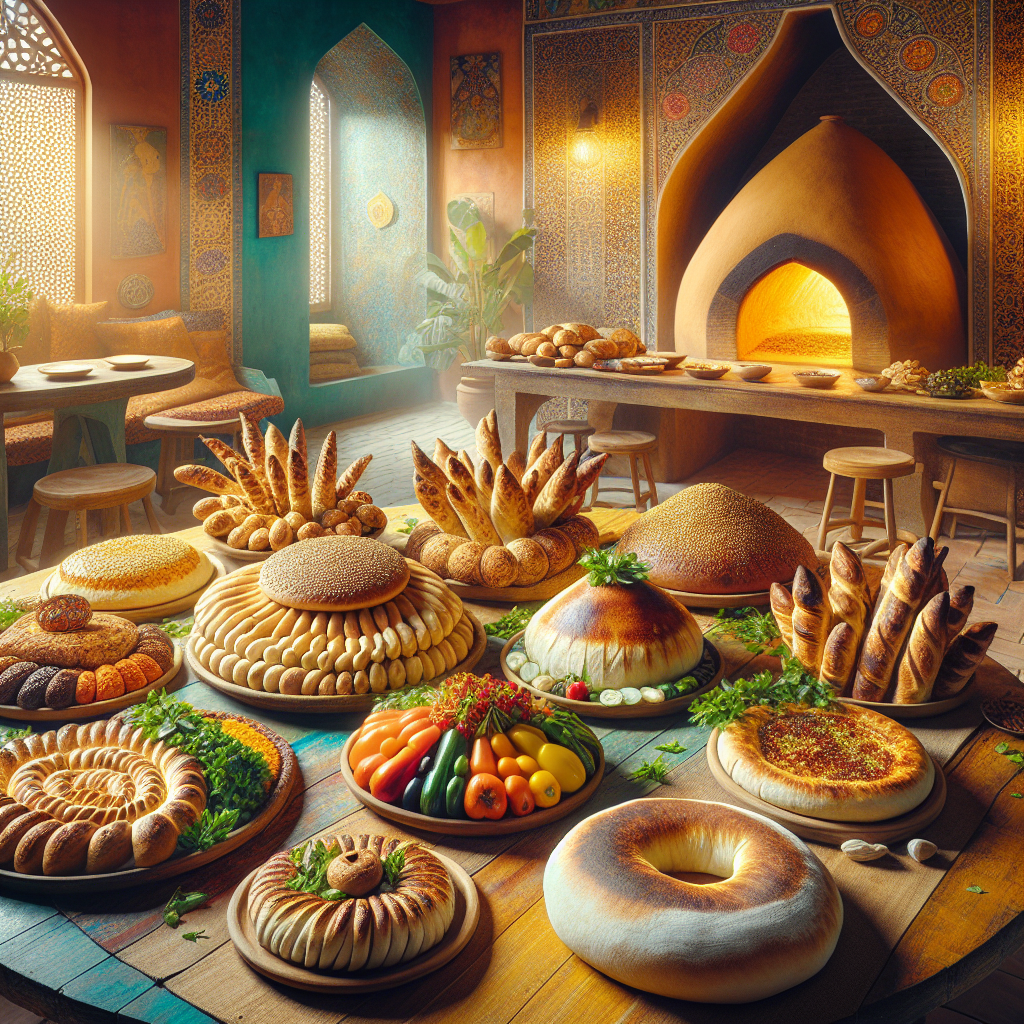Persian breads hold a unique place in the rich tapestry of Iranian cuisine, yet they often remain overlooked in discussions about global bread varieties. This article aims to shed light on the diverse types of Persian breads, their historical significance, and their cultural importance in daily Iranian life. As a culinary enthusiast with a background in food history, I am excited to explore the intricate ways in which these breads are crafted and enjoyed. My thesis posits that Persian breads are not only a staple food but also a vital element of Iran’s cultural identity, reflecting the nation’s geography, traditions, and communal practices. In the following sections, we will delve into the various types of Persian breads, such as lavash, sangak, and barbari, examining their unique characteristics, preparation methods, and the roles they play in both everyday meals and festive occasionas. By the end of this article, readers will gain a deeper appreciation for the artistry and significance of Persian breads in the culinary world.
Historical Roots of Bread in Iran
Ancient Origins of Persian Breads
The history of bread in Iran can be traced back to ancient civilizations, where it served as a fundamental staple in the Persian diet. Archaeological evidence suggests that the earliest forms of bread were made from grains such as barley and wheat, dating back to around 6000 BCE. The Sumerians and ancient Persians utilized a variety of grinding techniques to produce flour, which was then mixed with water to create a dough. This primitive process laid the groundwork for the diverse range of breads that would develop in the region over the millennia.
As the Persian Empire expanded, so did the techniques and recipes associated with bread-making. The Achaemenid Empire (c. 550–330 BCE) is noted for its advancements in agricultural practices, which included improved irrigation systems that increased wheat cultivation. The invention of clay ovens during this period allowed for more efficient baking, resulting in the creation of various types of flatbreads. One of the earliest recorded types of Persian bread is “lavash,” a thin, unleavened flatbread that remains popular in contemporary Iranian cuisine.
Influence of Geography on Bread Making
The diverse geography of Iran has significantly influenced its bread-making traditions. From the rugged mountains of the Alborz to the vast plains of Khuzestan, local climates and available resources have shaped the types of grains used and the methods employed in baking. In arid regions, for instance, barley and millet were favored due to their drought resistance, while in more fertile areas, wheat became the primary grain.
Furthermore, the cultural interactions facilitated by trade routes, such as the Silk Road, introduced new ingredients and techniques to Iranian bread-making. For example, the use of sourdough fermentation, which originated in ancient Egypt, found its way into Persian kitchens, leading to the development of more complex breads. The geographical diversity also encouraged regional variations, with each area producing its unique style of bread that reflects local tastes and traditions.
Evolution of Bread Recipes Over Centuries
Over centuries, Persian bread recipes have evolved, adapting to changing tastes, technologies, and cultural influences. The introduction of yeast in the Middle Ages marked a significant turning point, leading to the emergence of leavened breads such as “barbari” and “sangak.” These breads not only became integral to Persian meals but also gained recognition for their distinct textures and flavors.
Today, while traditional recipes are still cherished, modern variations have emerged that incorporate contemporary ingredients and methods. Health-conscious consumers now experiment with whole grains, seeds, and gluten-free alternatives, reflecting a growing trend towards healthier eating. Additionally, the fusion of Persian bread-making techniques with international cuisines has led to innovative creations that maintain the essence of traditional breads while appealing to a broader audience.

In conclusion, the historical roots of bread in Iran reveal a rich tapestry of cultural exchange, geographic influence, and culinary evolution. This ancient staple continues to be a beloved element of Persian culture, bridging the past with the present and highlighting the enduring significance of bread in Iranian society.
Key Varieties of Persian Breads
Lavash: The Versatile Flatbread
Lavash is a traditional Persian flatbread that is renowned for its flexibility and adaptability in various culinary contexts. Typically made from simple ingredients such as flour, water, and salt, this bread is characterized by its thin, crispy texture. It is often cooked in a tandoor, a traditional clay oven, which imparts a distinct smoky flavor. Lavash can be used as a wrap for grilled meats, vegetables, or cheeses, making it a staple in Persian cuisine. Additionally, it serves as an excellent accompaniment to dips such as hummus or yogurt-based sauces, enhancing the overall dining experience.
Sangak: The Stone-Baked Delight
Sangak, meaning “little stone,” refers to a traditional Persian bread that is baked on a bed of pebbles or stones in a specially designed oven. This unique baking method allows the bread to develop a crispy crust while remaining soft and chewy on the inside. Made from whole wheat flour, Sangak has a nutty flavor that pairs beautifully with various dishes, including stews and grilled meats. It is often served at special occasions and celebrations, highlighting its cultural significance in Persian society. The artisanal nature of Sangak also means that each loaf can be slightly different, adding to its charm.
Barbari: The Thick and Chewy Bread
Barbari is a distinctive Persian bread known for its thick, chewy texture and slightly crispy crust. It is typically made with a combination of white flour and whole wheat flour, giving it a unique flavor and density. The dough is often shaped into long oval loaves and traditionally topped with sesame seeds or a mixture of flour and water to create a beautiful glaze. Barbari is commonly enjoyed fresh out of the oven, served with a variety of toppings such as feta cheese, olives, or fresh herbs. Its hearty nature makes it an ideal bread for soaking up rich stews and sauces, making it a favorite among many.
Taftoon: The Soft and Flavorful Option
Taftoon is another beloved variety of Persian bread, celebrated for its soft and pillowy texture. Typically baked in a tandoor, Taftoon is made using a blend of flour, water, and yeast, resulting in a light yet flavorful bread. Its round shape and slightly thicker consistency allow it to hold up well when paired with a range of dishes, from kebabs to soups. Taftoon is often enjoyed warm, and it can also be stuffed with various fillings such as cheese or herbs, making it a versatile option for both casual meals and festive gatherings.
Other Notable Types: A Brief Overview

In addition to the aforementioned varieties, Persian cuisine boasts a rich array of breads that reflect the country’s diverse culinary landscape. For instance, Shirazi Bread is a thinner, crisper option often enjoyed in the southern regions of Iran, while Challah showcases the influence of Jewish baking traditions in Persian culture. Ghalieh bread, a specialty of the northern provinces, is known for its unique blend of spices and herbs that infuse the dough with flavor. Each type of bread carries its own story and significance, contributing to the rich tapestry of Persian culinary heritage.
Preparation Techniques and Ingredients
Traditional Baking Methods
Persian breads, known for their distinct flavors and textures, are traditionally baked using methods that have been passed down through generations. One of the most iconic techniques is the use of a tandoor, a clay oven that provides intense, direct heat, resulting in breads that are crisp on the outside and soft on the inside. The dough is often slapped against the walls of the tandoor, where it puffs up beautifully. This method is particularly popular for making lavash and sangak, both of which are staples in Persian cuisine.
Another traditional method involves baking on a hot stone or a metal plate over an open flame. This technique not only imparts a unique char to the bread but also allows for variations in thickness and texture. In many households, the process of preparing bread is a communal activity, where family members gather to mix, knead, and bake, reflecting the cultural significance of bread in Persian society.
In addition, the fermentation process is crucial in traditional baking. Many Persian breads utilize a sourdough starter, which enhances the flavor and improves the bread’s shelf life. The slow fermentation process also contributes to the bread’s chewy texture, making it a delightful accompaniment to various dishes.
Essential Ingredients Used in Persian Breads
The foundation of Persian breads lies in their simple yet high-quality ingredients. The primary ingredient is flour, with wheat flour being the most commonly used type. Different breads may call for specific varieties, such as whole wheat or white flour, which influence the flavor and texture. For instance, sangak is typically made with whole wheat flour, giving it a nutty flavor that pairs well with savory dishes.
Water is another essential component, as it hydrates the flour and activates the gluten, which is crucial for the bread’s structure. The addition of salt not only enhances the flavor but also regulates fermentation, ensuring that the dough rises properly. Yeast, either fresh or dry, is commonly used to leaven the dough, although some traditional recipes may rely on natural fermentation techniques.
Furthermore, ingredients such as yogurt, milk, or even eggs can be incorporated to enrich the dough, adding moisture and flavor. These additions are particularly prevalent in breads like barbari, which is known for its slightly sweet and rich taste. The use of sesame seeds or nigella seeds on top of breads before baking adds a delightful crunch and an aromatic finish, enhancing the overall eating experience.
Cultural Variations in Preparation Techniques
Persian breads exhibit a rich diversity influenced by regional customs and available ingredients. In northern Iran, for example, breads such as chadar are often prepared using a slightly different method that incorporates herbs and spices, imparting a unique flavor profile. The use of local grains can also vary, resulting in breads that differ in texture and taste across the country.
In southern regions, where the climate is hotter, breads are commonly baked in outdoor ovens, taking advantage of the ample heat. This not only affects the baking time but also the flavor, as the smoke from wood-fired ovens adds a distinct aroma to the breads.
Moreover, cultural practices play a significant role in the preparation of Persian breads. During festive occasions, families may engage in elaborate bread-making rituals, using special ingredients or techniques that are reserved for celebrations. This not only fosters a sense of community but also keeps the traditions alive for future generations.
Overall, the preparation techniques and ingredients of Persian breads are a testament to the rich cultural heritage of Iran, showcasing a blend of ancient practices and local flavors that continue to evolve.
Cultural Significance of Persian Breads
Role in Daily Iranian Meals
Persian breads, or “nan,” are an integral component of Iranian daily meals, serving not only as a staple food but also as a cultural symbol. Common varieties such as Sangak, Barbari, and Taftoon are often present at breakfast, lunch, and dinner, reflecting the diverse culinary practices found within the country. Typically, these breads are served alongside various dishes, such as stews (khoresh), grilled meats (kebabs), and fresh vegetables. The flatbread’s ability to complement a wide range of flavors enhances the dining experience and showcases the harmonious balance of Iranian cuisine.
Most families enjoy their bread freshly baked, purchased from local bakeries where the methods have been passed down through generations. The ritual of breaking bread together fosters a sense of community and belonging. Moreover, the preparation and consumption of Persian bread are often accompanied by traditional customs, such as spreading homemade butter or cheese on warm slices, which further enriches the meal. In many households, bread is regarded as a sacred item, and it is customary to treat it with respect, ensuring that none is wasted.
Breads in Festive and Ritual Occasions
During festive occasions and religious rituals, Persian breads take on even greater significance. Events such as Nowruz (Persian New Year) and Yalda Night feature unique bread varieties that symbolize abundance and prosperity. For instance, special breads like “Shirin Nan” are often prepared for celebrations, showcasing intricate designs and flavors that are not typically found in everyday varieties. These breads serve as not only food but also as a centerpiece for gatherings, where families and friends come together to celebrate their heritage.
Moreover, in religious ceremonies such as Ashura, bread plays a vital role in communal meals shared among the community. It symbolizes unity and the sharing of blessings among participants. These events often see large quantities of bread being prepared and distributed, emphasizing the generosity and hospitality intrinsic to Iranian culture. The act of sharing bread during such occasions reinforces social bonds and highlights the importance of community support in Iranian society.
Symbolism and Community Practices Surrounding Bread
Bread in Persian culture is steeped in symbolism, often representing sustenance, life, and the nurturing aspects of community. The saying “Naan-e khodavand” translates to “bread is a gift from God,” illustrating the reverence with which it is regarded. This perspective is reflected in various community practices, such as the traditional offering of bread at religious gatherings and memorial services, where it is believed to bring blessings to both the living and the deceased.
In addition, bread-making is a communal activity in many rural areas of Iran. Women often gather to bake bread together, sharing techniques and recipes that have been handed down through generations. This practice not only strengthens community ties but also preserves cultural heritage. The communal oven, or “tannour,” serves as a hub for social interaction, where stories are exchanged, and friendships are forged over the craft of baking. This collective approach to bread-making highlights the importance of shared traditions and the role of bread as a symbol of communal identity in Persian culture.

In essence, Persian breads are far more than mere sustenance; they embody a rich cultural tapestry woven through daily life, festive celebrations, and communal practices, reflecting the values and traditions that define Iranian society.
Modern Trends and Innovations
Contemporary Takes on Traditional Breads
The evolution of Persian breads has given rise to contemporary interpretations that honor traditional techniques while incorporating modern culinary trends. For instance, the classic Lavash, a thin flatbread that has been a staple in Persian cuisine for centuries, is now being reimagined with a variety of flavors and ingredients. Artisanal bakeries are experimenting by infusing Lavash with herbs, spices, and even cheese, resulting in unique offerings that cater to a diverse palate.
Moreover, the rise of gluten-free diets has prompted innovative bakers to create gluten-free versions of traditional Persian breads. By utilizing alternative flours such as almond, chickpea, or quinoa, these bakers are not only preserving the essence of Persian bread but are also making it accessible to those with dietary restrictions. This fusion of tradition and modern dietary needs exemplifies a significant trend in contemporary baking, where heritage meets innovation.
Additionally, social media platforms have played a crucial role in popularizing these contemporary takes. Photogenic bread creations, showcasing colorful toppings and enticing textures, have gone viral, encouraging home bakers to experiment with their own versions of Persian breads. This trend not only celebrates Persian culinary heritage but also fosters a sense of community among food enthusiasts.
Fusion Recipes Incorporating Persian Breads
The culinary landscape is increasingly embracing fusion recipes that blend Persian breads with global cuisines. One notable example is the use of Barbari, a thick, crusty bread, as a base for gourmet pizzas. Topped with traditional Persian ingredients such as saffron-infused chicken, feta cheese, and fresh herbs, this dish marries the textures of the bread with vibrant flavors, creating a unique gastronomic experience.
Another innovative fusion dish is the Persian-style quesadilla, where thin sheets of Sangak bread are used to encase a mixture of spiced lamb, roasted vegetables, and tangy yogurt sauce. This approach not only elevates the traditional quesadilla but also introduces Persian elements that enhance the overall flavor profile.
Moreover, the trend of brunch menus featuring Persian bread-inspired dishes is on the rise. Chefs are incorporating traditional breads into breakfast items such as avocado toast, topped with poached eggs and a sprinkle of sumac, providing a fresh and exciting twist on a beloved classic. These fusion recipes not only highlight the versatility of Persian breads but also demonstrate their ability to adapt to and enrich other culinary traditions.
The Global Influence of Persian Baking Techniques
Persian baking techniques are gaining recognition on the global stage, influencing bakers and chefs around the world. The use of tandoor ovens, for example, has transcended cultural boundaries, with many chefs adopting this method to create a variety of breads and dishes. The high-temperature cooking environment of a tandoor allows for the development of unique textures and flavors that are difficult to achieve through conventional baking methods.
Furthermore, the principles of slow fermentation and the use of natural leavening agents, such as sourdough starters, are being embraced by artisanal bakers globally. This technique not only enhances the flavor and nutritional profile of the bread but also aligns with the growing consumer demand for artisanal and handcrafted products.
Additionally, the emphasis on quality ingredients in Persian baking—such as the use of organic grains and fresh herbs—has sparked a broader movement toward sustainable and locally sourced food. Bakers are increasingly recognizing the importance of transparency in their ingredient sourcing, leading to a shift in consumer preferences toward products that reflect these values.
In conclusion, the global influence of Persian baking techniques is evident in various culinary practices, and as these methods continue to inspire chefs and home cooks alike, the legacy of Persian breads is set to thrive in modern gastronomy.
conclusion
In conclusion, Persian breads are not only a fundamental aspect of Iranian cuisine but also a reflection of the country’s rich cultural heritage and history. From their ancient origins, where they served as a staple food, to the various key varieties such as Lavash and Taftoon, these breads have adapted and evolved over millennia. The traditional preparation techniques and unique baking methods showcase the skills and craftsmanship that have been passed down generations, further emphasizing their cultural significance. Today, as modern trends influence culinary practices, Persian breads continue to be reinterpreted, blending traditional flavors with contemporary innovations. This enduring legacy of Persian breads highlights their importance in daily life and festive occasions alike, making them a cherished symbol of Iranian culture. As they adapt to modern tastes while retaining their historical roots, Persian breads remain a vital and beloved component of the nation’s culinary landscape.






